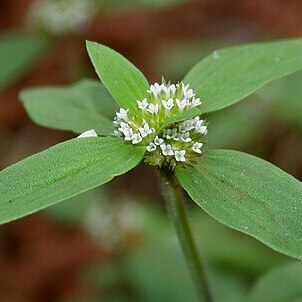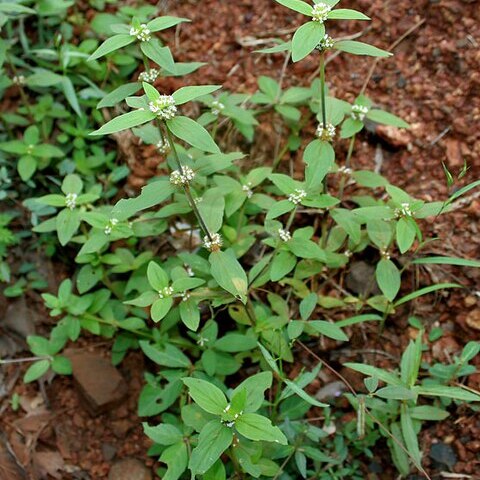A weak erect, decumbent or procumbent annual herb, usually ± well-branched, 3–40 cm. tall, with fine fibrous roots; stems with sparse to fairly dense crisped hairs on the ± wing-like prominent angles.. Leaf-blades elliptic to elliptic-lanceolate, 0.4–3.6 cm. long, 0.25–1.6 cm. wide, rounded to ± acute at the apex, concavely narrowed into the petiole at the base, glabrous on both surfaces save for short marginal hairs or ± pubescent on the main nerve beneath; petiole 0–8 mm. long, with scattered hairs; stipules with base 2 mm. long, bearing ± 7 fimbriae 1–3 mm. long.. Flowers in small few-flowered clusters at many of the nodes, attaining 3–6 mm. in diameter in the fruiting state; stipule-like bracteoles with fimbriae 1.8–2 mm. long.. Calyx-tube transversely oblong, 0.5 mm. long; lobes 2(–4), 0.6–0.8 mm. long, ciliate.. Corolla white; tube 0.3 mm. long; lobes triangular, 0.35 mm. long, 0.3–0.4 mm. wide, with a few short hairs inside.. Anthers situated just above the sinuses of the corolla-lobes.. Style ± 0.2 mm. long; stigma 0.2 mm. wide.. Fruit oblong, 1 mm. long, 0.8 mm. wide, 0.5–0.7 mm. thick, compressed, finely transversely wrinkled and very shortly pubescent.. Seeds chestnut-brown, oblong-ellipsoid, 0.7–0.8 mm. long, 0.4 mm. wide, 0.3–0.35 mm. thick, strongly reticulate with raised ribs, the foveae elongated in the direction of the short axis.. Fig. 50/19, p. 342.
More
A herb. It can be erect or lie over. It can be 40 cm tall. The roots are fine and fibrous. The leaves are narrowly oval and 0.4-3.6 cm long by 0.25-1.6 cm wide. They are rounded at the tip. The flowers are in small groups at the nodes. They are 3-6 mm across. The fruit are oblong and 1 mm long by 0.8 mm wide.
Waste places, disturbed soil, along canals and marshes, in grassy fields and along roads; at elevations from sea-level up to 650-1,400 metres.


